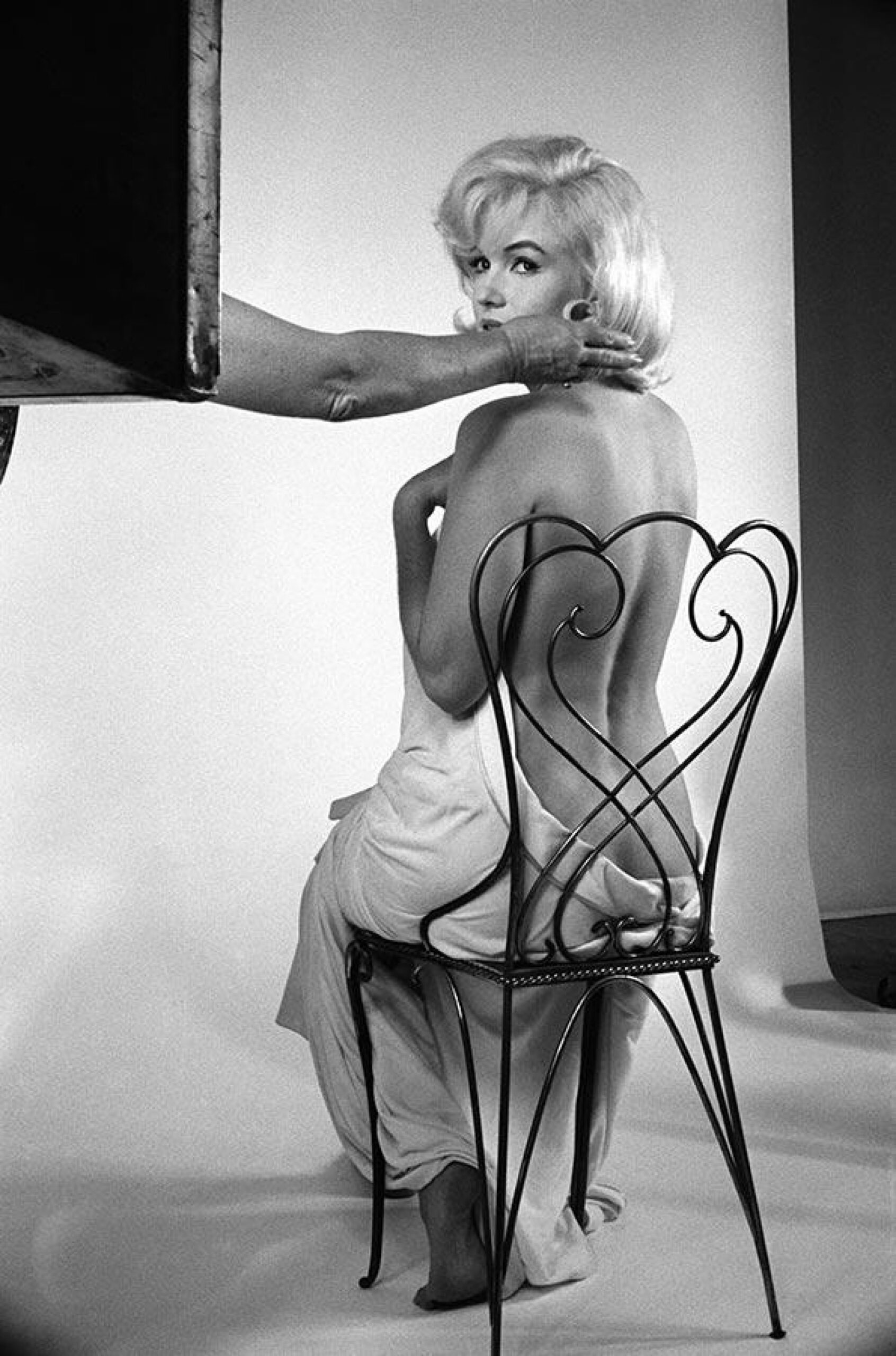
Przyjaźń między modelką a fotografem:
Eve Arnold zaczęła fotografować Marilyn Monroe po tym, jak aktorka zobaczyła zdjęcia Marlene Dietrich w Esquire. Spotkały się na przyjęciu, a Monroe stwierdziła: „Skoro tak świetnie Ci wyszło z Marlene, czy możesz sobie wyobrazić, co mogłabyś osiągnąć ze mną?” Tak rozpoczęła się ich współpraca zawodowa, która po latach przekształciła się we wzajemną przyjaźń. Arnold sfotografowała Monroe sześć razy w ciągu dekady. Najkrótsza sesja trwała dwie godziny, a najdłuższa dwa miesiące, kiedy widywała ją codziennie podczas kręcenia filmu The Misfits.
Aparat uwielbiał Marilyn Monroe, a Marilyn uwielbiała pozować, jak mówi fotograf Eve Arnold. To w jej studio zrobiono zdjęcie po lewej stronie. W Hollywood, gdzie najważniejsza jest kontrola wizerunku gwiazdy, sesja w studiu może być pokazem samym w sobie, wymagająca współpracy wielu asystentów, wizażystów, firm cateringowych.
Przyjaźń Eve Arnold z Marilyn Monroe trwała ponad dekadę i pozwoliła jej na fotografowanie codziennego życia aktorki w sposób, w jaki niewielu innych fotografów potrafiło.
Tylko kilka zdjęć pochodzi z reżyserowanych sesji studyjnych; większość była wykonana na planie filmowym, w kasynach lub po prostu wtedy, gdy Marilyn nie patrzyła. Połączenie reporterskich umiejętności Arnold i wyglądu Monroe tworzy niesamowite zdjęcia.
Ale mimo to na każdym zdjęciu – niezależnie od tego, czy jest w letniej sukience, grając w bilarda w 1960 roku, czy zakładając górę od bikini na Long Island w 1955 roku – Monroe udaje się zachować swoją pozę gwiazdki. Daje to wspaniałe obrazy, ale jaki to musiał być dla niej wysiłek, aby ciągle “grać”.
I pomimo wszystkich prób Arnold, Monroe nigdy tak naprawdę nie zdejmuje “maski” – byłoby prawie ciekawiej zobaczyć ją bez makijażu.
Arnold chciała wyjść poza seksualność Monroe, na której tak koncentrowali się inni fotografowie. Jednak przy tych wszystkich intencjach intymność między fotografem a obiektem sprawia, że zdjęcia i tak, aczkolwiek pozytywnie, emanują zmysłowością.
The camera loved Marilyn Monroe-and Marilyn loved posing, according to veteran celebrity photographer Eve Arnold, in whose studio the picture at right was taken. In Hollywood, where control of the star’s image is all important, a studio session can be a show in itself, requiring technicians, assistants, makeup artists, caterers-not to mention the star’s entourage (Monroe brought a gang of seven friends to lend support at this shoot). Recalling that day in her book Marilyn Monroe: An Appreciation (Knopf; 1987), Arnold tells us that it took three or four hours simply to prepare the star for the camera: because she was to pose in a bikini and a slip, full-body makeup was required, including shading and highlights. “When Marilyn finally emerged from the dressing room, she was sparkling: hair, face, body, fingernails and toenails all newly attended to. Her entourage applauded.”
Hollywood photographers strive for the same result as veteran TIME cover photographers Gregory Heisler and William Coupon, or legendary portraitists Yousuf Karsh and Arnold Newman: they hope to create an icon, an idealised, almost platonic realisation of the subject’s essence. But the studio environment is inherently limiting. As Arnold notes, “A studio session … provides the greatest chance for control. [But] even though there is total freedom, I still dislike studio photography and the contrived images that usually stem from this genre.” Philippe Halsman, another highly regarded portrait photographer, also chafed at the studio’s formality. He finally came up with the notion of asking his subjects to jump at the end of his sessions, hoping the physical movement would help break down the decorum demanded by the situation.
Great portraits have their place: our mental image of Winston Churchill is likely to be Karsh’s famous shot of the great man’s glowering, bulldog countenance. Yet we crave informality. We demand the uncontrived. We want to see the powerful and the famous with their guard down. More than idealisation, we want revelation. And that demands access not the illicit access of the paparazzi, whose stolen images leave us feeling complicit in the theft of privacy they require. We want the access achieved by photographers who earn the trust of their subjects and return with images that expose their hidden places: X rays of the soul.
Zadanie 1. Przeczytaj tekst po lewej.
Wypisz słowa, których nie znasz i sprawdź w słowniku ang-ang.
Zadanie 2. Czy znasz słowa, które są podkreślone w tekście po lewej?
Spróbuj zgadnąć ich znaczenie.
Zadanie 3. Uzupełnij definicje słowami, które są wyróżnione (pogrubiona czcionka, lub/i są podkreślone). Słowa mogą być w tekście piosenki, lub w komentarzach.
- _____________ make great efforts to achieve or obtain something.
- _____________ in a permanent, essential, or characteristic way.
- _____________ show strong approval of (a person or action); praise.
- _____________ a group of people attending or surrounding an important person.
- _____________ not appearing artificial.
- _____________ (with reference to a part of the body) make or become sore by rubbing against something; become or make annoyed or impatient because of a restriction or inconvenience.
- _____________ forbidden by law, rules, or custom.
- _____________ behaviour in keeping with good taste and propriety.
- _____________ deliberately created rather than arising naturally or spontaneously; created or arranged in a way that seems artificial and unrealistic.
- _____________ a conception of or belief about something.
- _____________ involved with others in an activity that is unlawful or morally wrong.
- _____________ successfully bring about or reach (a desired objective or result) by effort, skill, or courage.
If you are careful with people, they will offer you part of themselves. That is the big secret.
